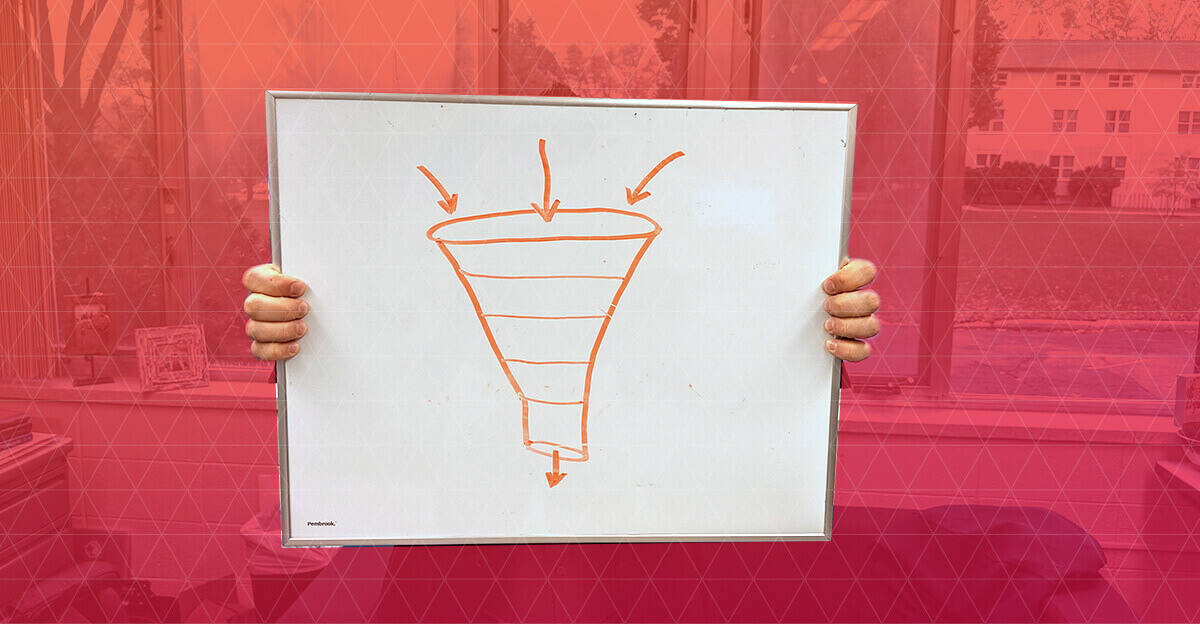For years marketing funnels have been a critical tool for my “for-profit” jobs and clients. It was always a critical part of the planning process and for troubleshooting issues in the sales pipeline.
Yet, when I began to work with nonprofits, this common marketing tool was little known and rarely used. This was partly due to archaic nonprofit CRM tools that had no way to track sales pipelines, but I also often ran into a belief that the donor development process was to complex for the marketing funnel.
Yet, I’ve found that, while nonprofits did require a modified funnel, the model still worked for them just as well.
What is a nonprofit marketing funnel? A marketing funnel is a business term used to illustrate a typical path taken by prospects customers to a sale with the shape signifying that more people start the journey than convert to a sale. The same term is used for nonprofits to illustrate the path taken to become a donor with more prospects starting their journey at the top than make it to the bottom of the funnel to become donors.
Note About Terms: In case you are wondering. The nonprofit marketing funnel goes by a variety of other names: nonprofit fundraising funnel, cultivation funnel, donor acquisition funnel, donor funnel, or the nonprofit sales process. They are all terms covering the same concept.
Fortunately, technology for nonprofits has improved and the funnel does indeed work to plan and track the progress of prospects becoming donors. It did need a few tweaks, however, so I’ll spend the rest of the article expanding on how nonprofits should think about marketing funnels.
The Nonprofit Marketing Funnel
After over a decade of working on both for-profit and nonprofit organizations, I’m convinced for-profit organizations have it easy in marketing (or at least easier—marketing is tough regardless).
Get The Audience Growth Checklist 🚀
Your content deserves an audience. Find out how to get the reach it deserves.
In a for-profit world, marketers simply need to identify and find the customers who know they need a solution to their specific problem. You serve them up an ad with a solution that addresses their problem and their desire to solve their own problem pulls them into the funnel. They are motivated to buy.
In a nonprofit world, you are generally trying to get people to think and care about other people’s problems. None of your target audience wakes up thinking they want to give away some of their hard-earned money. Their motivation is very low to give. This is a tall order to fill.
Because of this, nonprofit marketers have to work extra hard at educating their target audience about the problem in the world they are working to address. By default, most people are not aware of the problem and, if they are, do not care enough to make a single small donation. As nonprofit marketers, it’s our job calling to change that.
The funnel below is an attempt to arrange the different prospective donor and donor stages into a funnel that we use at Bethany International to help organize our marketing and communications efforts to increase our donations.

Of course, a single diagram like this needs an explanation, so read on to learn more about the different sections and how to put them to work to increase your donor base.
The Different Stages of Prospects & Donors In the Funnel
The funnel image above can be summarized by this table. For every step in the funnel, a prospect/donor takes an action to enter a new stage. Each stage has a correlating marketing designation and next steps that need to be taken to enter the next stage of the funnel.
| Action Taken | Funnel Stage | Marketing Designation | Needs to |
| None | Problem Unaware | Target Audience | Needs to be exposed to marketing/communications material. |
| Saw | Problem Aware | Lead | Needs more education to understand the significance of the problem. |
| Provoked | Engaged | Lead | Needs to learn more about the solutions and given chances to give in small ways. |
| Donated | Committed | Donor | Needs to be celebrated and shown the impact of their small gift. Encouraged to learn about the impact of a recurring gift. |
| Gave Recurring Donation | Committed | Recurring Donor | Needs to be treated as an on going partner with frequent briefings and progress reports (bad or good). They are your team. |
| Gave Major Donation or Designated Planned Giving | Committed | Major Donor | Needs to be commemorated to feel like they are establishing a legacy. |
The table shows a summary of the stages so here is a longer explanation of each stage.
Problem Unaware Target Audience
Unless your nonprofit is addressing a problem that has had worldwide media coverage lately, most of the Earth’s population is unaware of the problem you are trying to solve. You could look at this pessimistically and wonder why the world doesn’t care or you could look at it like I do and say “Look how many opportunities there are for people to discover and partner with us”!
Of course, you can do diligence in selecting your target demographics and psychographics to narrow the scoop and increase the odds that your marketing dollars and time are spent reaching the people most likely to engage with your nonprofit.
Problem Aware Lead
If a prospective donor has given you their contact information at some time, then it’s safe to assume they saw some of your marketing materials. It could have been your website, brochure, presentation, referral, or social media piece, regardless, they have seen something and gave you their contact information to learn more.
You can assume they learned something about the problem you address and you have their contact information, making them a “lead”.
The worst thing you can do at this point is nothing. Leads need to be followed up with, educated about the nuances of the problem you solve and given opportunities to work with you to address the problem.
Just because a lead understands your problem, doesn’t mean that they care. They certainly don’t care enough to give yet, so all communications should be aimed at getting them to take some small step that signifies that they understand the problem enough to care.
Engaged Lead
An engaged lead is one that you know now cares about the problem. They may have volunteered at an event or done something as small click a link an email titled something like “Top 10 Ways To Make a Difference for [insert cause]”.
At this point, the prospective donor has become a lead and taken action of some kind (even if very small) that indicates that they understand and care about the problem you address. They are now ready to be sent appeals for donations.
Most nonprofits make the mistake of sending appeals to everybody they have contact information for, but this is not only becoming less and less effective but offensive to some prospective donors.
Committed Donor
These donors have given a gift of some kind, even if it is as little as $3. Don’t take it for granted though. By giving even a small sum, they have indicated that they are now committed to the cause. They proved that they cared enough to part with their hard-earned cash.
These donors should be thanked and praised for their contributions. Think about how few even make it to this stage.
Since getting a one-time donor to give a second gift is much easier than getting a prospective donor to give once, time and marketing dollars are well spent trying to get this donor to give again. This isn’t done by simply firing off another appeal either. It’s done by informing them about how their donation was used to change the world first and then inviting them to amplify their impact by considering the next stage of the funnel.
Pro Tip: The more specific you can be about how donors money was used, the better. If they gave to your animal shelter, can you tell them how the money was used and the impact it made? Can you tell them which animals it affected? This is why child sponsorship works so well. It’s highly specific.
If you have thanked, praised, and shown how their donation was put to use, they are ready for an invitation to become a recurring donor.
Committed Recurring Donor
By setting up a recurring donation, this donor has become one of your most dedicated supporters. They should be thanked and praised often as well as given a mixture of simple and detailed progress reports about the impact their donation is making.
These donors may be interested in supporting other initiatives with additional one-time gifts, but only send appeals in proportion to the amount of the engagement a recurring donor is showing. They may be happy setting up the donation and forgetting about it knowing their money is being put to good use. Other donors may want to attend every event, sign every pledge, and be with you every step of the way.
The key is to continually nurture these donors to retain them as a partner for as long as you can.
Committed Major Donor
Some donors may become major donors on their first gift or after hundreds of gifts when they leave their estate to your nonprofit in their will. Because of this, it’s important to treat all donors with the kind of dignity, kindness, and respect knowing they can one day be major donors.
Major donors generally want more detailed reports of how their donations were put to use and need to be thanked by helping them fully realize the legacy they will leave.
How The Marketing Funnel Is Useful
Marketing funnels are more than formalities. They are tools that are put to use on a daily basis. Here are the primary two ways the funnel above has brought value to my work.
Targeted Marketing Tactics
I often find that nonprofits are trying to get too much out of a single marketing piece. They send an email expecting it to inform prospects, engage them in social media, elicit donations, and thank them for their last donation. In this way, marketing is like cooking, fewer simple ingredients taste better.
If you have a well-defined funnel, you can better target your messaging. If you need more donations you can think about what needs to be done to get more leads, what you can do to engage them, and what appeals those engaged leads will respond to.
An email, for example, should only be used to try to get one stage of prospects/donors to take a single step. Your website, on the other hand, is more complex in that it addresses multiple stages and needs to be carefully designed to fulfill the needs of each one, though I typically utilize 80% of the website to get new visitors to be problem aware.
Troubleshooting Conversion Points
Once you have marketing strategies to address each stage of the funnel, it is easier to measure how well you are doing at each point.
I love showing these metrics to organizations for the first time. The numbers of people moving through the funnel always reveal where the problems are and empower the organization to begin working on solving the correct problem.
Once you are measuring each stage, you can track your conversion rates from month to month for evergreen campaigns or for campaigns. The conversion ratios provide a baseline that you can improve and use to forecast future growth.



